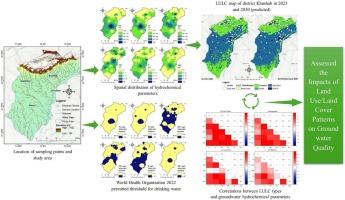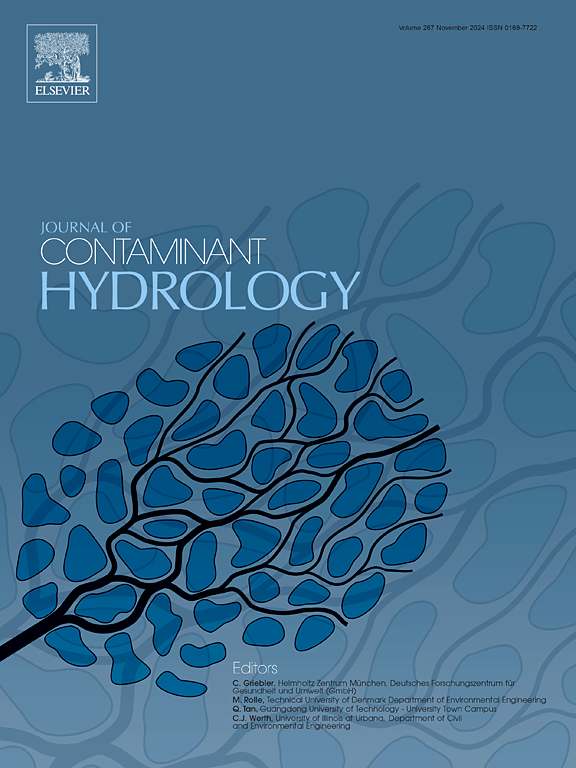Geochemical modeling, evaluation of contaminants and impacts of land use, land cover patterns on groundwater quality in Khushab, Pakistan
IF 4.4
3区 环境科学与生态学
Q2 ENVIRONMENTAL SCIENCES
引用次数: 0
Abstract
Urbanization and land use/land cover (LULC) transitions exert significant pressure on groundwater resources, particularly in semi-arid regions where reliance on groundwater is high. This study assessed the effects of LULC on groundwater hydrochemistry in Khushab district, Pakistan, by analyzing 155 groundwater samples alongside geospatial mapping and statistical modeling. Hydrochemical distribution patterns revealed elevated sodium (Na+), chloride (Cl−), sulfate (SO₄2−), fluoride (F−), and magnesium (Mg2+) concentrations in agricultural and urban zones, reflecting inputs from fertilizers, wastewater infiltration, and industrial activities. The Curved Streamline Searchlight Model (CS-SLM) identified distinct LULC and ion linkages: Na+, Cl− and F− associations in agricultural land, SO₄2−, Mg2+ and Na+ relationships in built-up areas, and Na+, Mg2+ and Cl− correlations in rangelands. To assess future risks, LULC dynamics were simulated using a Multilayer Perceptron and Markov Chain Analysis (MLP-MCA) model, projecting substantial increases in agriculture (+14.7 %), built-up land (+25.4 %), and forest (+23.5 %) by 2030, accompanied by declines in rangeland (−24.3 %) and water bodies (−15.8 %). These changes are expected to further elevate Na+, Cl−, SO₄2−, and Mg2+ levels in agricultural and urban aquifers, posing risks to groundwater quality and sustainability. The findings provide new evidence that rapid LULC change directly shapes groundwater chemistry, highlighting the urgent need for integrated land and water management practices. Sustainable agricultural inputs, improved wastewater management, and protective policies for rangelands and water bodies are essential to mitigate future degradation of groundwater resources.

巴基斯坦Khushab的地球化学模拟、污染物评价和土地利用、土地覆盖模式对地下水质量的影响
城市化和土地利用/土地覆盖(LULC)的转变对地下水资源造成了巨大压力,特别是在高度依赖地下水的半干旱地区。本研究通过分析巴基斯坦Khushab地区155个地下水样本,并结合地理空间制图和统计模型,评估了LULC对地下水水化学的影响。水化学分布模式显示,在农业和城市地区,钠(Na+)、氯化物(Cl−)、硫酸盐(SO₄2−)、氟化物(F−)和镁(Mg2+)浓度升高,反映了肥料、废水渗透和工业活动的投入。曲线流线探照灯模型(CS-SLM)发现了不同的LULC和离子联系:农用地中Na+、Cl−和F−的关联,建成区中SO₄2−、Mg2+和Na+的关联,以及牧场中Na+、Mg2+和Cl−的关联。为了评估未来的风险,使用多层感知器和马尔可夫链分析(MLP-MCA)模型模拟了LULC动态,预测到2030年农业(+ 14.7%)、建设用地(+ 25.4%)和森林(+ 23.5%)将大幅增加,同时牧场(- 24.3%)和水体(- 15.8%)将减少。这些变化预计将进一步提高农业和城市含水层中的Na+、Cl−、SO₄2−和Mg2+水平,对地下水质量和可持续性构成威胁。这些发现提供了新的证据,表明LULC的快速变化直接影响了地下水的化学性质,强调了对土地和水综合管理实践的迫切需要。可持续农业投入、改善废水管理以及牧场和水体保护政策对于缓解未来地下水资源退化至关重要。
本文章由计算机程序翻译,如有差异,请以英文原文为准。
求助全文
约1分钟内获得全文
求助全文
来源期刊

Journal of contaminant hydrology
环境科学-地球科学综合
CiteScore
6.80
自引率
2.80%
发文量
129
审稿时长
68 days
期刊介绍:
The Journal of Contaminant Hydrology is an international journal publishing scientific articles pertaining to the contamination of subsurface water resources. Emphasis is placed on investigations of the physical, chemical, and biological processes influencing the behavior and fate of organic and inorganic contaminants in the unsaturated (vadose) and saturated (groundwater) zones, as well as at groundwater-surface water interfaces. The ecological impacts of contaminants transported both from and to aquifers are of interest. Articles on contamination of surface water only, without a link to groundwater, are out of the scope. Broad latitude is allowed in identifying contaminants of interest, and include legacy and emerging pollutants, nutrients, nanoparticles, pathogenic microorganisms (e.g., bacteria, viruses, protozoa), microplastics, and various constituents associated with energy production (e.g., methane, carbon dioxide, hydrogen sulfide).
The journal''s scope embraces a wide range of topics including: experimental investigations of contaminant sorption, diffusion, transformation, volatilization and transport in the surface and subsurface; characterization of soil and aquifer properties only as they influence contaminant behavior; development and testing of mathematical models of contaminant behaviour; innovative techniques for restoration of contaminated sites; development of new tools or techniques for monitoring the extent of soil and groundwater contamination; transformation of contaminants in the hyporheic zone; effects of contaminants traversing the hyporheic zone on surface water and groundwater ecosystems; subsurface carbon sequestration and/or turnover; and migration of fluids associated with energy production into groundwater.
 求助内容:
求助内容: 应助结果提醒方式:
应助结果提醒方式:


